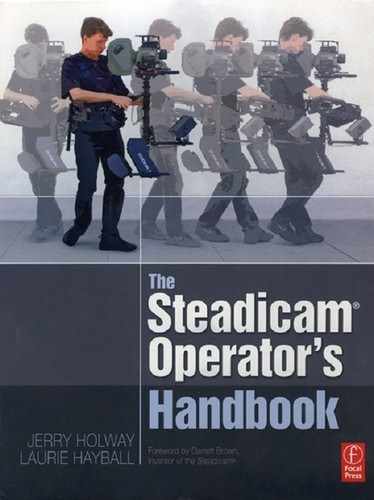Weather alerts
wind, rain, heat, cold
Wind
Wind is the invisible enemy of the Steadicam. Even the slightest breeze can alter your precise framing and ruin the shot. But there are several things you can do to minimize its effect.
Keep the wind off the rig
First and foremost is to try to keep the wind from hitting your rig in the first place.Typically, operators have a grip hold a “4-by” solid or double net next to the rig to keep the wind from hitting it. The challenge is for the grip to keep the solid in the right spot as you move about and the direction of the wind shifts.

Garrett always suggested that you keep a length of colorful yam in your kit and tie it to the mounting rod of the solid. You tell the grip to aim the yarn at the sled, not you. I've always found it hard to find the time, inspiration, or the spare 4-by to tie my yarn to, so I've still got that original piece of bright red yam from 1982 in my kit, untouched. Instead, I try to have two solids and two grips make a “V” around my back to keep the wind off the rig, regardless of the wind's direction. In addition I will use another grip and solid if needed and/or the bodies of the director DP assistant craft service technician etc huddled together to shield me from the wind
Some operators prefer using double nets rather than solids. Adouble will cut the wind down significantly, but there is less turbulence in the transition area from shielded to unshielded. It would be great to have the best of both worlds and make up your own shields that were solid at the center and like a double net all around the edges.
Using a V of solids, you can shoot looking directly into the wind. The V forms a little pocket of calm air, and you can operate quite well in winds of 25 mph or more. (However, it may require several grips to hold each solid.)
Larry McConkey has long had a custom triptych of 6 foot tall shields that clip together. Each shield has a Plexiglas window that the grip can look through to see what Larry is doing.

We often use grips to block the wind from the rig. The stronger the wind (wind force goes up by the square law), the bigger or more numerous the grips must be.
Increase the rig's inertia
You can also reduce the effect that the wind has on your rig by increasing the rig's inertia. Your first line of defense is extending the monitor and battery and lengthening the telescoping post. This is nice because it adds no weight to the rig and is generally very quick to do.
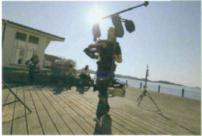
Your second option is to add some more inertia via Antlers (or a similar scheme). This is useful because you can orient the Antlers sideways (unlike the fore-aft orientation of all the other components) and even out the angular inertia in all three axes. When the wind hits a rig with Antlers oriented this way, it tends to be a lot less squirrelly — it tends to move spatially a bit, but not angularly.
Your third choice is to add gyros. This is a bit more challenging, as it often requires a major rearrangement of the sled's components and special brackets. It's also noisy and takes additional power. That being said, gyros can make your sled very, very stiff and wind resistant and are particularly good for lock offs at the head or tail of a shot when it is really critical.
Rain
You want to keep the rain out of your rig. The electronics in particular don't like the moisture, and there are steel parts in the arm that can rust. It won't hurt the vest to get wet, but it's not much fun to wear it once it is soaked.
Covering the gear
Several companies make custom covers for the arm and sled; you should have a GoreTex or similar rainproof but breathable shell to go over your vest.
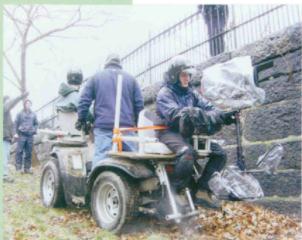
We like the pre-fab gaiters for the arm, but a big plastic garbage bag also works like a charm. Just poke a small hole in the closed end for the arm post, gather it loosely about the center elbow and the hinge near the vest, and you are good to go.
I prefer wrapping the monitor and the electronics in clear plastic wrap to using the custom covers. If moisture does get inside the plastic wrap, you just cut it off and start again, and the plastic wrap presents less of a wind shadow than the custom covers.
Start wrapping the monitor with one clean, dry layer stretched over the monitor face. Then wind more plastic round and round until you think the monitor is protected. Secure with duct tape — not gaffer tape — and rubber bands or bungee cords.

Start wrapping the electronics at the bottom, and wind your way up and around everything until the electronics are covered. The wrappings will act like shingles on a roof, and you secure the top layer to the post with duct tape. Use rubber bands where you can.
The battery on some rigs can be covered with a ziplock type bag, secured with a rubber band. On other rigs it's best to use the plastic wrap method.
You generally cover the camera as the assistants would like to cover it, but try to minimize the wind shadow. The camera cover generally covers the stage and electronics adequately. Forget about the gimbal. It gets wet and does not care.
One of my favorite rain moments was for a Woody Allen movie, Celebrity. In a big scene at the end of the film, a crowd has gathered outside a movie theater for the premier. It's raining — artificially from a large number of towers. It's about 40° out, the extras cringe every time the AD calls “roll sound,” and I'm having a fine time shooting under the marquee, far from the freezing deluge. Having a fine time, that is, until they suggest I go out into the street.
But this is a big movie with lots of resources. I quickly commandeer four grips and an “Easy-Up” tent. We roll the edge to create a gutter on the front, and I can march about the street fully protected from the rain, but not from the glare of the extras' eyes.
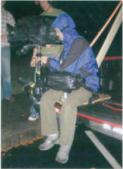
I've also worked many times all day or night in the pouring rain and wind and mud and, with the protections mentioned above, come away without a scratch. When you can, it's nice to have an umbrella or Easy-Up follow you around. When you can't, it's generally not a big deal.
Water and sand
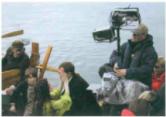
Sand gets everywhere and water is very corrosive, especially salt water.
The beach is a very hostile environment for a Steadicam. Cover your gear as if it were pouring rain. Even for that one quick shot, one gust of wind or one splash could result in hours of maintenance work on your rig.
Temperature extremes
Steadicam operators have worked all over the world under the most extreme conditions. The equipment, with a few minor precautions,can operate from -40°F to over 120°F (-40°C to +500C). Under these extreme conditions, however, the operator must work hard to take care of himself or herself.
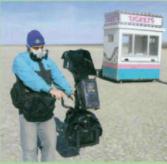
A trick for running on sand
Bury a length of chicken wire or plastic fencing just beneath the surface of the sand It works like snowshoes!
Hydrate
Whether it's hot or cold, or just a lovely spring day, proper hydration is a must. Alternate water and a sports drink if you are working hard. Drink some water followed by the sports drink. Then more water. The liquids should be at room temperature, so it's more easily absorbed with less shock to your system. Drink a little bit all the time; don't wait until you are thirsty. If you are dehydrated, you risk cramping or fainting, and you tend to think more slowly. Plus, you are thirsty.
Cold climates
As the temperature drops, the operator must add more and more layers of clothing. Down to about 0°F, nothing really extraordinary is called for. A layer of good moisture wicking material next to the skin (like polyester) should be followed by several layers of fleece and a final rain- and wind-resistant layer. All layers should be loose enough to allow good circulation, and you should be able to open up your clothing between takes to vent out the moisture generated while you shoot.
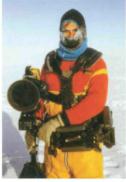
The vest should be worn outside all but the outer shell, with the socket block protruding through a gap in the zipper. Many operators have special slits sewn into their clothing to accommodate the socket block, but a lot of us just use off the rack jackets.
In conditions below zero, be sure to add extra insulation on the outside of the vest spar. The spar not only compresses the insulation under it, but it acts like a giant heat sink, sucking the heat out of your heart. We've discovered the hard way it can be very painful. Maybe even fatal if you're in the rig too long.
Hands and feet

As the temperature drops,you need to consider when you should start wearing gloves and how thick should they be. Should your gloves be smooth or sticky? Your decision should be based partly on the shot requirements, and partly on how your hands feel to you at the moment. Some of us have less circulation in our hands and quickly start putting on the gloves; others wait a lot longer. When it's just a little bit cold, some people like thin leather gloves others may prefer latex or half gloves with the fingers cut off.
It's a good idea to go to sporting goods stores and see what different athletes use — you may find something from kayaking that suits you just fine. Operators who typically work in cold environments have many different pairs of gloves and mittens in their kit.
Chemical hand and foot warmers are great for keeping you warm, especially when you opt to grab the cold post with your bare fingers for the moment of shooting, and then return your hand to the glove between takes.
Always take care of your feet. Unfortunately, as your boots get bigger and thicker to ward off the cold, they don't necessarily provide the same positive support as your normal operating shoes. Combine clumsy boots with ice and snow and you risk falling with your gear. If you know you will be working in the snow and ice, find boots that keep you warm and provide secure footing and proper support.
Batteries and monitor
Most batteries do not work very well when cold. Try to keep them above 40°F. Many operators charge their batteries and keep them ready in an insulated cooler with an electric blanket inside. Wrap the battery in an insulated bag when it's on the rig, and if necessary, put one of those little hand warmers in the bag with the battery.
LCD (liquid crystal display) screens do not like to operate below freezing — the liquid freezes. Many LCD monitors have automatic circuits that prevent them from operating below freezing unless you choose to do so. Normally, the LCD screens made for Steadicam use have large backlights that generate a lot of heat. You can keep your LCD warm in cold weather by insulating the back of it and keeping it on with the backlight set to maximum brightness. When docked, place an insulated cover over the screen.
If you know you are going to spend a lot of time in below freezing weather, we suggest you buy a commercial 14 or 24 volt DC power supply (at the same voltage as your batteries) of the right amperage (10 amps is more than sufficient for most rigs). Make an adaptor cable and use the mains to power the rig and keep everything warm between takes. Place your battery into the insulated cooler and go find a warm spot for yourself
Hot climates
When it's hot, you need to keep yourself and the equipment as cool as possible. For the gear, it's generally best to turn everything off so that it generates no heat, and keep everything out of the sun. There's nothing quite like putting on a black vest that's been baking in the sun and then humping 70 pounds around. Keep yourself and all of your equipment in the shade.

Once again, you must take special care of the batteries, as they don't like to be hot, and they generate heat when being used and when charging Many batteries and chargers have thermal circuitry to prevent charging or discharging when the temperature is too high. Be sure that your charging station is in the shade and that there is plenty of air circulating through the charger.
Stay hydrated. Do not drink iced drinks, and stay away from sugary sodas. Tepid water and sports drinks may not sound appetizing, but they will keep you working longer with less stress on your body.
Wear a hat, maybe even one of those hats with a small fan built into it. If it's dry enough, wrap a towel soaked in cold water around your neck — especially when you are not wearing the rig. And wear the rig as little as possible. Stay cool.
Wear loose, light-colored clothing that can breathe: nothing tight or constricting. If there's a reflection in a shot that requires you to wear black, then wear black for the shot and then change back into your normal hot weather costume.
Take care of your feet. They will really appreciate it if you change your socks and shoes at least once during the day. Soaking your feet in a bucket of cool water can be heavenly.
When it's really hot, we do not jump in and out of an air conditioned building or vehicle. Stay outside in the shade and get used to the heat Your body will sweat, keeping you cool.
It may seem strange, but don't forget to warm up and stretch when it's hot. Stay loose.
Whenever you travel from one environment to another, be sure to pace yourself. If you live in New England and suddenly find yourself shooting in Panama, it's going to take a few days to get used to the heat and humidity. Altitude, jet-lag, new food, pollen, or pollution can also wreak havoc on your body. Have your assistants watch you carefully, making sure you don't get dehydrated or overextended. A day that would be okay back home can knock you out in “paradise.”

